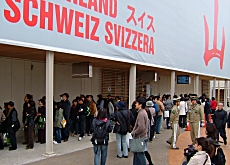
Heidi airbrushed out of Expo 2005

Heidi, the mountain girl who every Japanese knows comes from Switzerland, has been all but excised from the Swiss pavilion at Expo 2005.
In her place is an exhibition space which seeks to prove that there is more to the alpine nation than watches, chocolate and snow-capped mountain peaks.
The designers of the Swiss pavilion in Japan have not completely abandoned familiar clichés.
The exhibition space has been built in the shape of an imaginary alpine mountain range, complete with obligatory observation platform from where guests are encouraged to take souvenir photographs.
As they take in the view – including a distant alpine peak which bears a close resemblance to the Matterhorn – the sound of cow bells is pumped intermittently through speakers hidden inside the mountain.
An adjacent restaurant sells rösti, raclette and bowls of Birchermüesli.
While the exterior of the exhibition may look, sound and taste familiar to the thousands of visitors expected to pass through it over the next six months, the interior could not be more different.
Lighting the way
At the entrance to the pavilion, visitors are handed a genuine pocket Swiss Army torch and guided into a dimly-lit holding room, before double-doors are dramatically swung open and they are led into near darkness.
The lamps light the way inside the exhibition and also act as audio guides, providing descriptions of the objects on display.
“The idea is that you walk inside and see a different side to Switzerland,” said architect Andreas Reuter.
“We want to show people that there is much more to the country than meets the eye.”
Juri Steiner, curator of the pavilion, told swissinfo that the aim was to showcase Switzerland’s diversity.
“We collected the material to be put on display by travelling across the country and contacting more than 100 institutions, museums and individuals.”
The end result is an exhibition space divided loosely into a series of walk-through zones which begin in the past and take in Swiss mythology, the natural world and famous Swiss scientists, inventors and adventurers.
Wooden dog
Taxidermists will be disappointed to discover that the life-size reproduction of Barry, the legendary St Bernard dog said to have rescued more than 40 mountaineers caught in avalanches, is wooden rather than stuffed.
But there are also genuine articles, including the helmet worn by Swiss skier Bernhard Russi when he took gold at the 1972 Winter Olympics in Sapporo.
Other prominent Swiss included in the hall of fame include astronaut Claude Nicollier, adventurer Bertrand Piccard and Ernesto Bertarelli, the billionaire who bankrolled Switzerland’s Americas Cup-winning Alinghi sailing team.
One of the most valuable items on display is Albert Einstein’s Swiss passport, which takes pride of place in the “Top of Science” zone.
“We wanted to show people that Einstein was – at least for a period during his life – a Swiss citizen. The only chance to see his passport is here in the pavilion,” said Steiner.
Exhibition organisers are very protective of the faded document: it is locked away each night in a back-office safe.
Power of nature
A section called “Risks and Caution” displays objects connected to the central theme of the 2005 Expo: the power of the natural world.
An aircraft tailfin, smashed to pieces when a hurricane struck Switzerland just over five years ago, is displayed next to a more macabre exhibit: the 400-year-old remains of a female British visitor to the Swiss Alps who died after falling onto a glacier.
“We are putting her [hair and] bones on show as part of this exhibition,” said Steiner.
The scene of destruction gives way in the last zone of the exhibition to a celebration of modern Swiss scientific research and innovation.
An award-winning robot designed to help partially paralysed patients and stroke victims walk again is placed opposite a display celebrating the work of scientists who came up with a three-dimensional blueprint for reconstructing Afghanistan’s destroyed Bamiyan Buddhas.
Return to daylight
At the end of the walk-through tour, a set of electronic revolving doors spews visitors out of the dark interior of the exhibition and onto the top of the Swiss mountain.
It’s an abrupt return to stereotypical Switzerland, as small groups of visitors compete for space to photograph themselves in front of the artificial Alps.
“We hope by the end that visitors will be surprised and feel challenged by what they have seen,” said Manuel Salchli, director of the Swiss pavilion.
He rejects any suggestion that visitors are likely to leave disappointed that Heidi has been edited out of this 21st-century vision of Switzerland.
“Firstly, Heidi is actually here. She’s in our restaurant, where you can buy the ‘Heidi’s Favourite’ set menu.
“And secondly, if anybody asks me where Heidi and the Swiss cows have gone, I’ll just say ‘come and find them in Switzerland’.”
swissinfo, Ramsey Zarifeh in Aichi, Japan
The Swiss pavilion, built at a cost of SFr15 million ($12.9 million), is divided into a series of zones: “Swiss Myths”, “Visions”, “Risks and Caution” and “Top of Science”.
Objects on display include an early version of the Alinghi sailing team’s yacht and a scale model of the hot-air balloon used by Swiss adventurer Bertrand Piccard to circumnavigate the globe.
Organisers expect up to ten per cent of the 15 million visitors to the Expo to visit the Swiss pavilion during the exhibition’s six-month run.

In compliance with the JTI standards
More: SWI swissinfo.ch certified by the Journalism Trust Initiative





























You can find an overview of ongoing debates with our journalists here . Please join us!
If you want to start a conversation about a topic raised in this article or want to report factual errors, email us at english@swissinfo.ch.